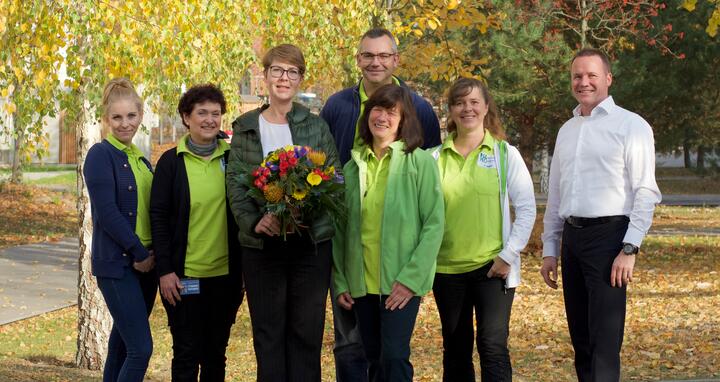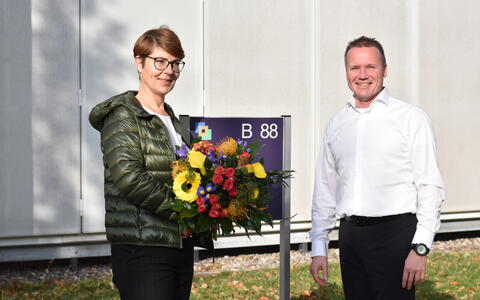What’s a “normal” kidney?
Professor Niendorf, since 2014 you have been examining eight to ten participants every day using magnetic resonance imaging (MRI). This is in addition to the evaluations being performed at four other national MRI centers as part of the GNC. What are you going to do with these huge amounts of data?
Prof. Thoralf Niendorf welcomes the 5000. participant Annette Anacker.
Thoralf Niendorf: We will soon evaluate the kidney-related data collected from 15,000 participants in the GNC study. This will require the use of artificial intelligence. We are developing an algorithm based on 200 training data sets for machine learning that will enable us, first, to automatically determine kidney size and then to establish standard values according to age, sex, and weight. This means the algorithm will be “let loose” on the remaining data sets. Because of the cohort’s large size, we have reliable reference values for the first time: The sheer amount of data provides the statistical power needed to establish standard values.
What else is planned in terms of data analysis?
TN: My colleague Professor Tobias Pischon, who heads the GNC study center at the MDC, wants to define standard values for cardiac functions. For example, cardiac mass and heart volume are key parameters used in clinical practice to assess cardiac performance. Having standard values for such parameters is important for an accurate prognosis. If there are problems with the patient’s values, that is, if they deviate from the standard values, this information makes it easier to determine if the patient is at risk of heart failure.
The people participating in the GNC are contributing enormously to the advancement of health research in Germany
Ms. Anacker, today you are the 5,000th participant to be examined at the MDC as part of the first phase of the MRI study. How did you become a GNC participant?
Annett Anacker: I received invitation letters in May and June asking me to take part in the GNC. I didn’t get around to responding to the first letter, but when the second one came I thought, “Well, I can certainly do that.”
Why did you agree to participate?
AA: After reading the letter, I wasn’t exactly sure what the study entailed. So I called the GNC and inquired about what examinations would be done. The tests sounded interesting, and I was curious to find out how healthy I was.
Professor Niendorf, why is it so important to both the GNC and the MDC that participants like Annett Anacker are willing to take part in the cohort study?
TN: By making such a commitment, the people participating in the GNC are contributing enormously to the advancement of health research in Germany. Plus, the MDC is benefiting from being part of the GNC in many ways. On the one hand, it enhances the Center’s profile and reputation. On the other, it is extremely important for translational research at the MDC. So we’re very thankful that Ms. Anacker and many other people from Berlin and Brandenburg are ready and willing to take part in the GNC study.








